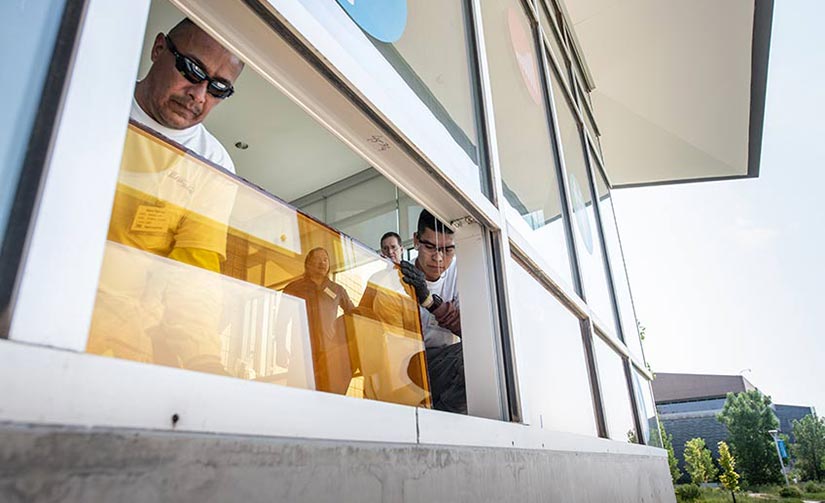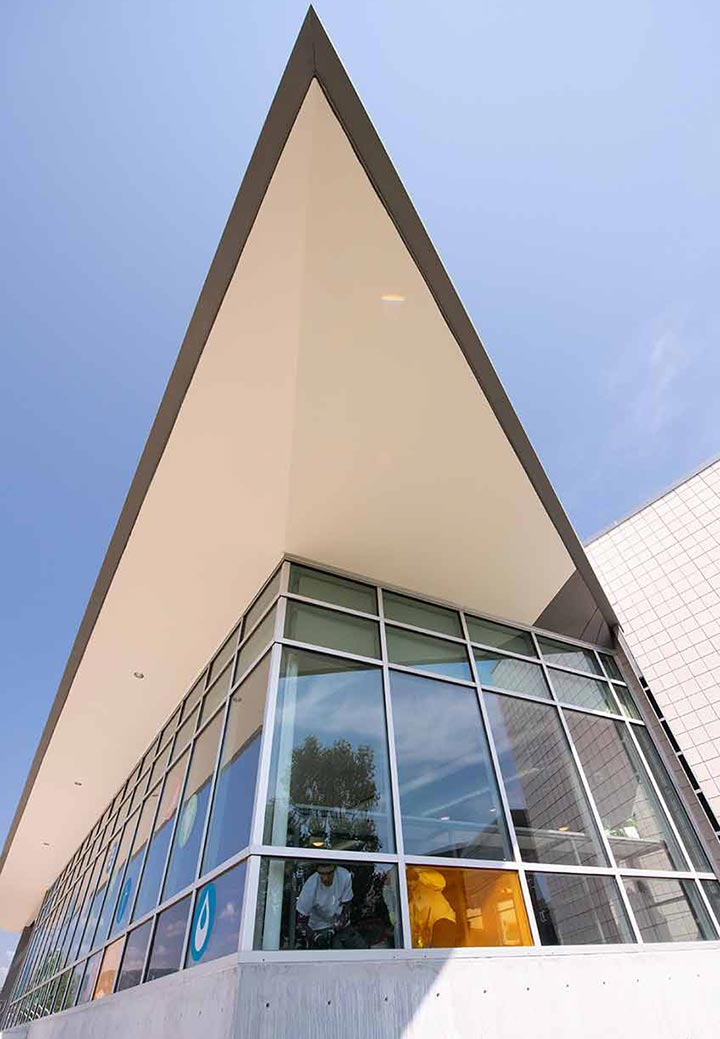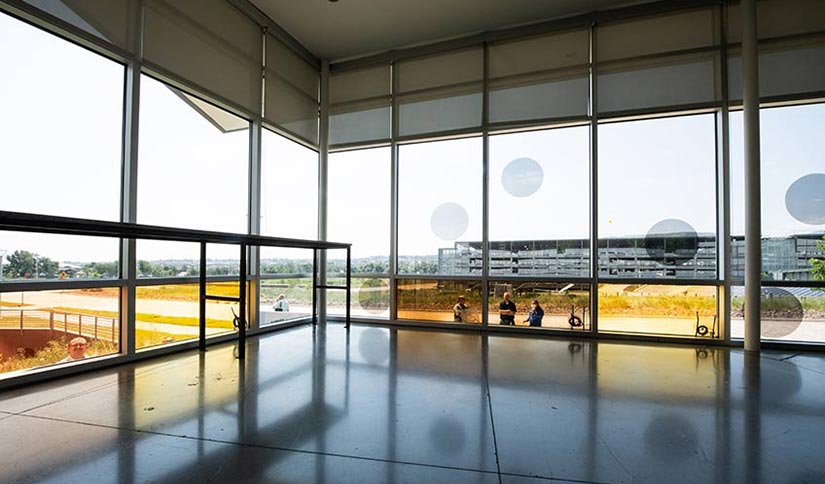Connecting the Dots To Enhance Energy Efficiency, Workforce, and Low-Carbon Buildings

A true living laboratory, the National Renewable Energy Laboratory (NREL) added a small but noticeable splash of color to its cafeteria building. Five quantum dot windows were installed this summer as a demonstration project evaluating innovative windows technologies, in collaboration with UbiQD and the Wells Fargo Innovation Incubator (IN2) program. The windows will remain installed for one year as NREL and UbiQD collect data on their performance.
The quantum dot (QD) windows are unique in the way they generate energy. The QD-laminated glass absorbs sunlight, then the glow from the QDs is trapped in the glass by total internal reflection, similar to how a fiber optic cable guides light. The light is then guided to the edges where silicon solar cells are located. This approach is called a “luminescent solar concentrator.”

The pieces of QD glass are part of an experiment to determine how windows can be used to address the need for more renewable resources in cities. The Department of Energy (DOE) Building Technologies Office (BTO) aims to transition windows from being attributed for four quads (quadrillion Btu) of energy consumption to net energy production through active and passive strategies.
UbiQD's solar windows are made from glass, laminated with a QD-doped interlayer. Quantum dots are nanoparticles that have highly efficient and size-tunable photoluminescence over a wide range of colors. UbiQD uses copper indium disulphide quantum dots because they are bright, safe, and affordable.
The type of quantum dots used to create the laminated interlayer determine the color of the window. The windows on campus are red, yellow/orange, and grey/tan colored.
“We can access nearly the entire color spectrum range with quantum dots, and so there is the customer option to create a really beautiful thing that makes a building pop in a fun way while also creating an impact,” said Hunter McDaniel, UbiQD founder and CEO. “The customer can also choose a more normal neutral color tint with our near-infrared dots, and we’ve installed two versions of that as well.”
The solar cells generate electricity that can either be stored or used for certain applications, said Chaiwat Engtrakul, NREL materials scientist, who will help with the window data collection.
“I’m excited to see this type of technology integrated into an actual building where we can real-time assess performance of this next-gen tech,” Engtrakul said.
UbiQD was founded in 2014 by McDaniel, a former Los Alamos National Laboratory (LANL) postdoc. The company licenses technology developed at universities and research institutions, such as LANL, Massachusetts Institute of Technology, and Western Washington University.
The company team’s history with NREL began more than 10 years ago as the result of an Energy Frontier Research Center (EFRC) program that was a collaborative effort between NREL and LANL to study solar energy conversion using quantum dots.
The company also participated in the DOE Small Business Voucher (SBV) Pilot Program with NREL in 2016, which was funded by the BTO. After the SBV project ended, UbiQD was accepted into the IN2 program. Through the years, NREL has assisted the company with early-stage materials work, building energy performance modeling, manufacturing economics modeling, and durability assessment of prototypes, said Robert Tenent, NREL materials science researcher and innovation lead for architectural windows. NREL is designated as a DOE core windows laboratory for advancing innovative window durability performance, which is critical to achieving long-term energy performance and market acceptance.
Through these efforts, UbiQD has grown to 24 full-time employees and plans to continue growing its workforce while simplifying the manufacturing and installation processes for windows.
Tenent said having the UbiQD windows installed at the Café is a significant accomplishment. He said, when you work for a startup, a lot of work goes into the process before you get to this point. He also sees this as evidence that basic science work that starts at NREL has lasting impact.
“This is a big deal for them to have been able to pull this off and come out of here,” Tenent said.
Windows of Opportunity
McDaniel views the installation as a major accomplishment for UbiQD. He said years of work went into the research and design process before the company was able to manufacture a window that could be installed in a real building.

Without the collective effort of his team, investors, and research laboratory and university partnerships, as well as support from multiple DOE programs and the Wells Fargo IN2 accelerator, this work would not have been possible.
“It’s a huge milestone for the company, for us, for me personally, and all the people who worked on this technology over the years, even those that aren’t directly involved with this specific install,” McDaniel said.
In cities, there is little room to install solar panels, but buildings have a lot of windows. McDaniel sees turning basic windows into energy-generating technology as an opportunity. This is consistent with BTO’s vision that includes several key window technologies including highly insulating, dynamic solar control, and electricity generating windows that can be integrated for optimal performance in any climate.
“Glass is ubiquitous,” McDaniel said. “So, if we can convert that glass in a low-cost way into a power generator, then it turns those buildings into not loads on the grid, but assets for the grid.”
He said windows are important to people. They bring natural light into homes and give buildings character. To UbiQD, using windows to help solve energy challenges is just one piece of the puzzle.
“As we move into the future, it’s important that there are lots of different solutions coming to the table,” McDaniel said. “It’s not just going to be one silver-bullet energy solution that saves us or allows us to be energy neutral; it’s going to be a lot of different technologies that are coming together in a symphony. Our solar window technology can help significantly on the energy production side of the equation, but we also will need building energy efficiency gains to meet in the middle for net zero.”
For more information about this work, visit the Wells Fargo IN2 program. Learn more about DOE’s pursuit of low-energy, low-carbon buildings.
About NREL Windows Research
For more than 35 years, NREL scientists have pioneered the evaluation, development, and demonstration of advanced windows research, which is critical to building performance and occupant comfort. These efforts support DOE’s goals to develop next-generation technologies that reach market adoption. Also, the ability to operate windows dynamically can also provide grid services when combined with sensors and controls.
Learn more about related windows research activities on the NREL Buildings website.
Last Updated May 28, 2025
